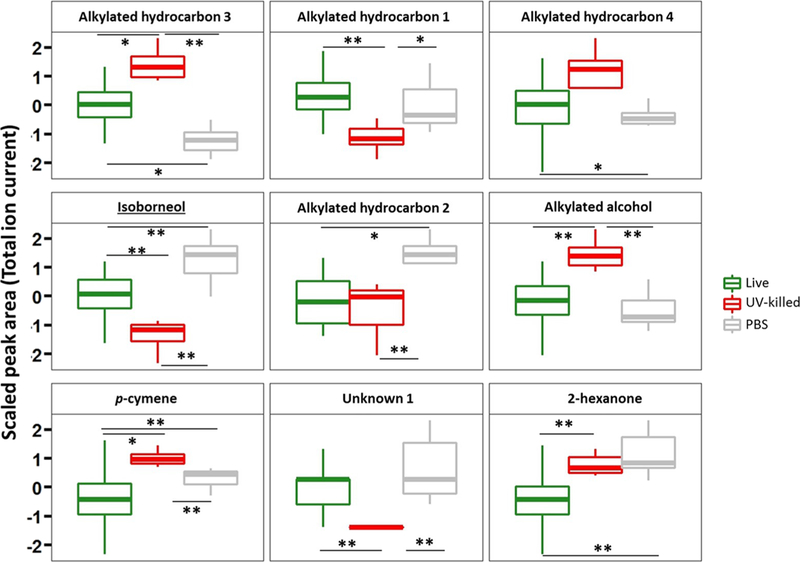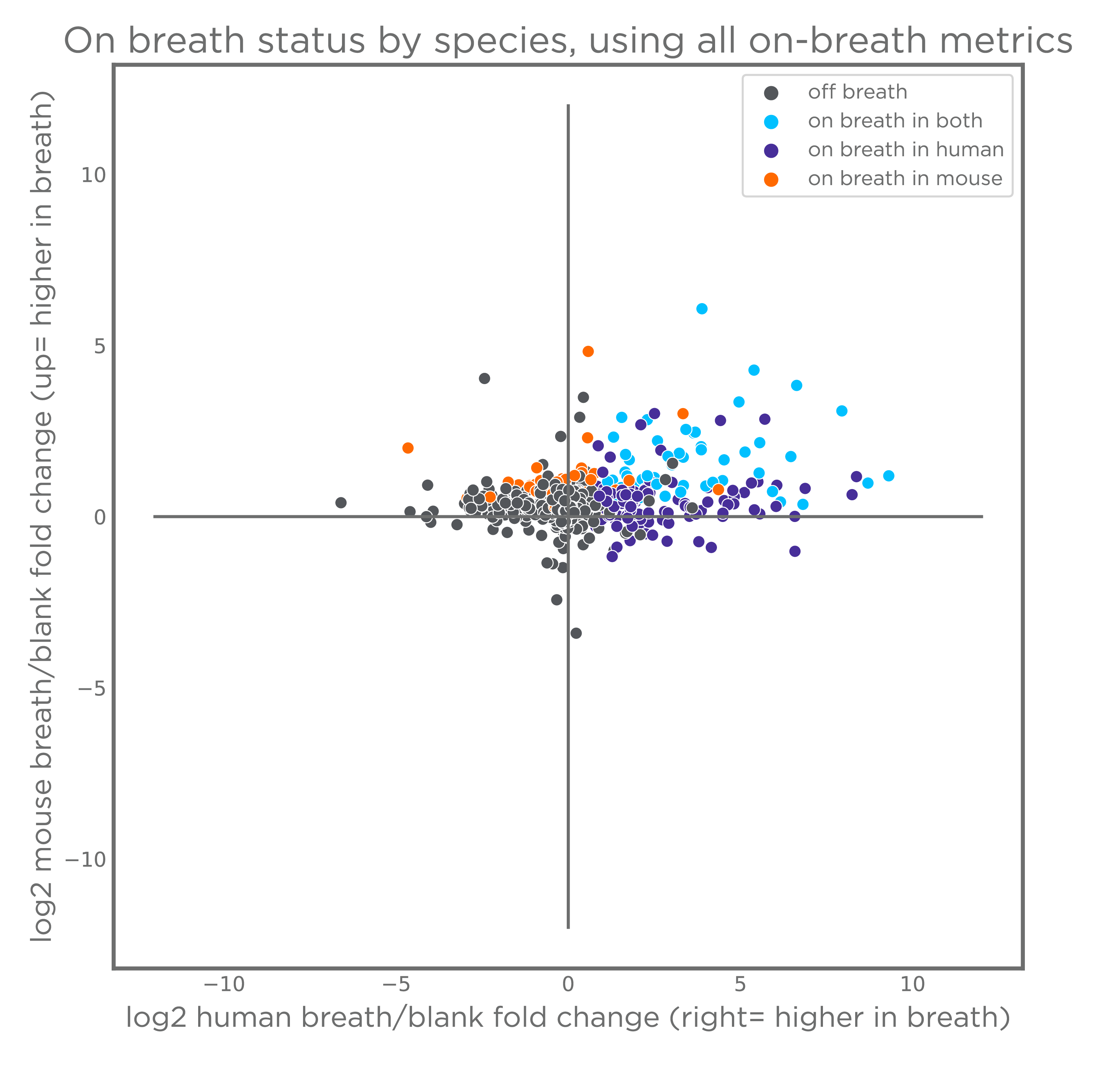Mouse Breath Analysis: The Key to Progression
Published on: 28 Oct 2024
VOCs in Mouse Breath
Volatile organic compounds (VOCs) are gaseous molecules that can be measured in exhaled breath. VOCs can provide a rich source of information regarding overall health and have the potential to be used as biomarkers for disease onset and progression. VOCs can originate from within the body (endogenous VOCs) or from external sources such as diet and environmental exposure (exogenous VOCs) (1), and can be produced throughout the body through many different metabolic pathways and disease processes. These compounds are distributed into the bloodstream where they travel around the body, exchange into the air in the lungs, and exhaled in breath.
Breath analysis is non-invasive, and many serial samples can be taken in rapid succession, making it advantageous over other sampling mediums such as blood and urine. Despite its many advantages, the breath research field faces several significant challenges. Identifying specific VOCs that correlate with diseases (discovery), confidentially linking VOCs with physiological processes in the body (validation), and developing tools that can be used in clinical settings (translation) are some of the hurdles that researchers face.
One of the most complex issues is validation – establishing causational links between VOC patterns and specific biological processes or diseases (2). While humans make ideal subjects for diagnostic research, variables like diet, environment, and microbiome composition cannot be controlled rigorously for biomarker validation. This is where pre-clinical animal models, such as mice, become essential.
How Can Mice Help Breath Research?
Using mouse models in breath research allows scientists to tightly control different variables. In mice models, researchers can use genetically identical mice to minimize individual genetic differences and manipulate diets, environments, and even the gut microbiome. This gives researchers complete control over factors that influence VOC production. This control allows for more precise experiments that can reveal specific biological processes and disease states that VOCs originate from.
It is also possible to model complex disease states in mice, such as infections or chemical exposures, and then correlate changes in breath VOCs with disease progression or severity (3). Mouse breath analysis can bridge the gap between laboratory discoveries and human clinical applications.
Mice VOC Breath Analysis and Infectious Disease
Infectious diseases are responsible for a huge global burden that impacts public health systems and economies worldwide, especially affecting vulnerable populations. Lower respiratory tract infections, diarrheal diseases, tuberculosis, and malaria are among the top causes of overall global mortality (4). Better biomarkers are needed for the early diagnosis of infectious diseases to reduce mortality rates.
A recent study on breath analysis in infected mice demonstrated the potential for identifying VOC biomarkers of Valley fever, a fungal infection caused by Coccidioides species. Up to 40% of patients with Valley fever experience symptoms ranging from mild respiratory infections to severe, life-threatening pneumonia (5). This study infected C57BL/6J mice with two different strands of Coccidioides and completed untargeted volatile metabolomics, as well as measured cytokine levels to evaluate immune response.
A total of 36 VOCs were significantly correlated with cytokine production, highlighting how specific VOCs produced by the host of infection can serve as potential biomarkers (5). These VOCs also correlated with the severity of infection with moderate-high cytokine production, which indicates that VOCs can provide information in the monitoring of disease severity.
Another recent study investigated the ‘breath-print’ of mice during lung infection of 4 different strains of P. aeruginosa. To focus on the origins of host VOCs during infection, some of the C57BL/6J mice were inoculated with UV-killed P. aeruginosa, which excludes metabolites produced by live P. aeruginosa from appearing in exhaled breath (3).
A panel of nine VOCs were selected and were able to classify mice breath samples based on the strain of P. aeruginosa administered with an accuracy of 81%. Some of these VOCs include p-cymene, 2-hexanone, and hydroxyethyl acetate. P-cymene was found to be highly abundant in the UV-killed group compared to the live group, demonstrating how some VOCs are produced by the host in response to P. aeruginosa infection.

Figure 1. Boxplot of VOCs used to discriminate live-group versus PBS versus UV-killed. doi: 10.1007/s11306-018-1461-6
The course of bacterial infection in mice has also been evaluated by monitoring changes in carbon monoxide (CO) levels (6). Mice were infected with Borrelia hermsii and elevated CO levels were found. These elevated levels decreased to normal levels within one day of antibiotic treatment, highlighting how VOCs can not only be indicative of infections but also can monitor the effectiveness of treatments.
Mouse VOC Breath Analysis and the Gut Microbiome
Over one billion people worldwide are affected by gastrointestinal illness, with the symptoms of these conditions being debilitating and affecting quality of life. Examples of these gastrointestinal conditions include small intestinal bacterial overgrowth (SIBO), irritable bowel syndrome (IBS), and inflammatory bowel diseases (IBD). These conditions have a strong connection with the gut microbiome.
A recent study took a novel approach by using gnotobiotic mice (mice with fully controlled microbiomes) to link specific VOCs in breath to different microbial species that are found in the gut microbiome. Mouse breath was collected using the SciReq FX1 Flexivent murine ventilator. This animal ventilator uses a unidirectional airflow for the collection of exhaled breath with minimal contamination (7). VOCs produced by gut microbes in pure culture were also collected to compare the VOCs found in mouse breath monocolonized with the same bacteria.

Figure 2. Overview of microbially-associated VOCs in culture headspace and the exhaled breath of monocolonized mice. Teal = E. coli, Orange = C. aerofaciens, Yellow = B. thetaiotaomicron, and Green = A. muciniphila. doi: 10.1101/2024.08.02.24311413
Methyl methacrylate, ethyl acetate, benzaldehyde, aldol, acetic acid, and 1,2,3-trimethylbenzene are VOCs that are identified in mouse breath that were associated with the bacteria E. coli. Mesitylene, 3-ethyltoluene, and 4-ethyl-1,2-dimethylbenzene are VOCs that were identified in mouse breath that are associated with the bacteria C. aerofaciens. Tridecane, dodecane, acetone, and 6-methyl-5-hepten-2-one are VOCs that were identified in mouse breath that are associated with the bacteria B. thetaiotaomicron. Hexanal is a VOC that was identified in mouse breath that is associated with the bacteria A. muciniphila (7).
These results show that microbe-derived VOCs found in mouse breath support the theory that gut bacterial metabolism directly contributes to exhaled breath VOC profiles.
This study was recently presented at the Breath Biopsy Conference 2024 by Dr Andrew Kau from the Washington University School of Medicine. You can watch Dr. Kau’s talk, as well as the other presentations from the conference here.
Owlstone Medical’s Mouse Work
In our collaborative study with researchers at Boehringer Ingelheim, we developed a method for accurately characterizing the VOCs in the breath of healthy intubated mice using GC-MS. We also compared the VOCs contained within mouse breath to system blank samples and compared the VOCs identified from intubated mouse models to the VOCs in human exhaled breath.
We collected mouse breath using the flexiVent® FX1 small animal ventilator to maximize the signal-to-noise by reducing the background signals from the fur, feces, urine, and oral microbiome of the mice. 472 compounds were found in total in mouse breath, with 15.47% (73) of these compounds identified as on-breath, meaning they were distinguished from background contaminating signals. Some of the VOCs that were confidently identified in mice breath include benzene, decane, cyclopentene, and 2-butanol. There were 49 common VOCs identified between mouse and human breath. Trimethylamine (TMA) and dimethyl sulfone are examples of on-breath compounds in both humans and mice that are significantly different from background signals.

Figure 3. A plot of the on-breath compounds identified in mouse breath and human breath by fold change compared to blank concentration. The off-breath compounds are shown in grey, those only in mice in orange, those only in humans in purple, and the on-breath compounds in both mice and humans are shown in blue.
This study presents a method for the robust capture and analysis of the VOCs contained in mouse breath, offering advantages over existing methods in the field. This method can also be used to compare the composition of mouse breath with human breath and therefore establish mice as a viable animal model for the study of breath biomarkers.
We are the world leaders in breath research, and we can help you include breath analysis in your research. Breath Biopsy OMNI can provide everything you might need to start or continue using breath analysis, and you can receive expert advice from our team of scientists. You can cross-check your data against our VOC Atlas to better understand more about the literature, and biology behind VOCs in your study and confidently validate your breath biomarkers. You can get in touch with our experts to discuss how our technology can be incorporated into your biomarker discovery workflow.
References
- Pleil JD, Stiegel MA, Risby TH. Clinical breath analysis: discriminating between human endogenous compounds and exogenous (environmental) chemical confounders. J Breath Res. 2013 Mar;7(1):017107. doi: 10.1088/1752-7155/7/1/017107
- Chou H, Godbeer L, Allsworth M, Boyle B, Ball ML. Progress and challenges of developing volatile metabolites from exhaled breath as a biomarker platform. Metabolomics. 2024 Jul 8;20(4):72. doi: 10.1007/s11306-024-02142-x
- Purcaro G, Nasir M, Franchina FA, Rees CA, Aliyeva M, Daphtary N, et al. Breath metabolome of mice infected with Pseudomonas aeruginosa. Metabolomics. 2019 Jan 7;15(1):10. doi: 10.1007/s11306-018-1461-6
- van Seventer JM, Hochberg NS. Principles of Infectious Diseases: Transmission, Diagnosis, Prevention, and Control. International Encyclopedia of Public Health. 2017;22–39. doi: 10.1016/B978-0-12-803678-5.00516-6
- Higgins Keppler EA, Van Dyke MCC, Mead HL, Lake DF, Magee DM, Barker BM, et al. Volatile Metabolites in Lavage Fluid Are Correlated with Cytokine Production in a Valley Fever Murine Model. J Fungi (Basel). 2023 Jan 14;9(1):115. doi: 10.3390/jof9010115
- Barbour AG, Hirsch CM, Ghalyanchi Langeroudi A, Meinardi S, Lewis ERG, Estabragh AS, et al. Elevated carbon monoxide in the exhaled breath of mice during a systemic bacterial infection. PLoS One. 2013;8(7):e69802. doi: 10.1371/journal.pone.0069802
- Hernandez-Leyva AJ, Berna AZ, Liu Y, Rosen AL, Lint MA, Whiteside SA, et al. The breath volatilome is shaped by the gut microbiota. medRxiv. 2024 Aug 8;2024.08.02.24311413. doi: 10.1101/2024.08.02.24311413
Catch up on the presentations from the Breath Biopsy Conference 2024

